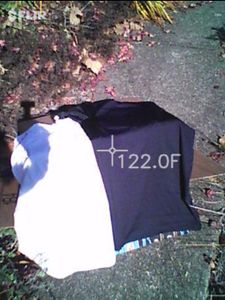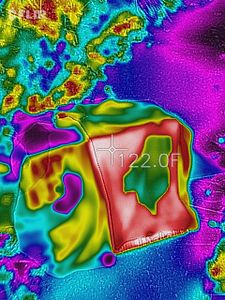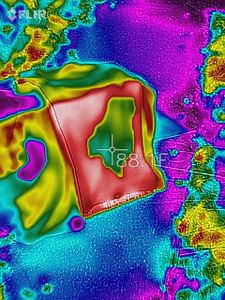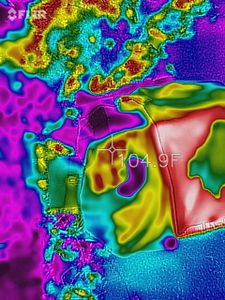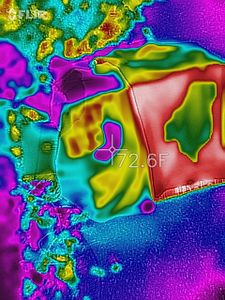UnderArmour HeatGear Review
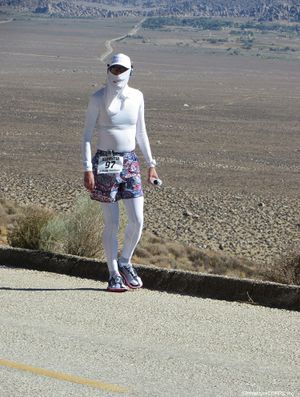
I’ve been wearing UnderArmour HeatGear since at least 2009, and it’s still the best option for most situations. I’ve run in HeatGear in a wide variety of conditions, from the intense dry heat of Death Valley during 2014 Badwater 135 to the oppressive heat and humidity of the 2010 Keys 100. HeatGear has a number of benefits. • It’s extremely thin, so it offers very little insulation. I’ve not found any top that is as thin. This thinness also allows sweat to spread out very rapidly, maximizing the cooling effect. • There are a range of colors including white. All too often, runners underestimate the impact of the heat from the sun on their running performance. While this is an obvious issue on a hot summers day, it’s also a significant factor in much milder conditions. For more on how heat impacts runners, see Impact of Heat on Marathon Performance. It’s worth noting that in mild conditions, the initial heat stress is perceived as tiredness or weakness rather than being too hot. • The compression fit helps prevent chafing, something that can be an issue on marathons, and a major problem during longer runs. While the construction is not seamless, I’ve never had any issues, even with my skin condition, and after long ultras. • The material offers good UV protection, and the compression tops are available in long sleeves. Protecting your skin from the sun not only has long-term health implications, but sunburn can cause problems during an ultramarathon, as sunburned skin cannot regulate your temperature effectively. • I’ve found that HeatGear is my preferred base layer in colder conditions. While you might expect a thicker base layer to be more effective, I’ve consistently preferred HeatGear over UA’s ColdGear or a number of other warmer base layers that I’ve tried. The big advantage of HeatGear is that it doesn’t hold much sweat. This can be a big deal in winter when you get a little too warm and start to sweat. At that point you’ll need to shed some insulation layers, or open some zippers. If you’re wearing a thicker base layer, it will take far longer to dry out, and you end up in the awkward situation of too warm or too cold. I found the HeatGear will try relatively quickly, making it far easier to regulate my temperature. • It’s surprisingly hard wearing, and I’ve had tops that have lasted a good number of years. There are a few situations where HeatGear is not the best choice. • The main downside I’ve found to HeatGear is that there is no odor resistance. This isn’t too much of a problem while training at home or racing, but I found it a major pain if I’m traveling and can’t wash my running gear regularly. I love merino wool, which has good natural odor resistance, but it’s expensive, fragile, and I’ve yet to find a compression top made of merino wool. For travel, the best option I’ve found so far for odor resistance is XOSKIN. • When it’s hot and humid enough that you are dripping with sweat and soaking through all clothing, it doesn’t matter so much that the thin material spreads out the sweat. HeatGear is still better than any other clothing I found because its thinness offers less insulation than you’d get with something thicker. However, if you’re out of the sun and sweating profusely, you may be better off with bare skin. This is not a huge difference, but running at night in intense heat and humidity, I sometimes prefer bare skin to HeatGear. • If you’re running in extreme heat, and very low humidity, then HeatGear works very well for protecting you from the sun and spreading out your sweat. In those situations, most runners tend to keep their clothing soaked by spraying themselves with water. If you can do this reasonably regularly, and then I think HeatGear works well, but other runners have had success with much thicker material that will hold more water, and therefore require less frequent dowsing. • A thin white top that’s wet does tend to be quite revealing, so this may be a factor. Black and White I performed this simple test of how black and white materials behave in the sun. I placed a black and a white HeatGear top over a cardboard box in a full sun. I dampened the middle of each with 2 tablespoons of water and left them for about 15 minutes. The air temperature was about 66f/19c. this test is not realistic, as the temperature of the shirts on their own will rise far higher than when they are worn. However, I believe it gives a good indication of how important it is to have light rather than dark clothing when you’re running.
Under Armour Iso-Chill Under Amour have a variation of HeatGear called “Iso-Chill.” UA claim that Iso-Chill feels cooler to the touch and it will “pull heat away from the skin, physically making you cooler.” I assume they mean the fabric will transmit heat more easily, but details are lacking. UA also claims Iso-Chill will increase the time taken to reach V̇O^=2^ max, but they give nothing to back up this claim. The only detail they do mention is treating the fibers with titanium dioxide, which is how I found Iso-Chill. There is research showing that titanium dioxide fabrics will reflect far infrared (heat) and improve infrared emissions. The idea is that you could have a fabric that’s dark but reflects heat like a white fabric. I decided to try some Iso-Chill fabrics and compare them with regular HeatGear. I already have a white long-sleeved top, and I ordered a white Iso-Chill top, along with camouflage-black Iso-Chill leggings and mostly white regular HeatGear leggings. I used some regular black 2XU leggings for a worst-case scenario.
A simple evaluation is to lay out each item of clothing in full sun and see how hot the get. This is a bit artificial as clothing is normally in contact with a body, but it gives an idea of the heat absorption. The white Iso-Chill top was coolest, at only 25c, with the white HeatGear top are warmer at 29c, a surprising difference. The mottled leggings are 33c, which shows how much the small amount of black mottling changes the temperature. The camo black Iso-Chill leggings are a toast 47c, and the 2XU are up to 52c. So, the color is still the dominating force in the temperature, but the Iso-Chill helps. I’ve run in all these items quite a bit, and my real-world findings match the thermal images quite well. The Iso-Chill top is a bit cooler than the normal white top, but it’s not a big difference. The black camo Iso-Chill leggings make a noticeable and worthwhile difference to the perceived temperature in full sun, and I’d always wear them over regular leggings if I was trying to stay cool rather than trying to stay warm. The mottled white leggings win out for hot sunning conditions if you don’t mind the look. Generally, I’ve had a mixture of complements and odd looks with the mottled white leggings, so it will depend on your aesthetic tolerance which you chose.
